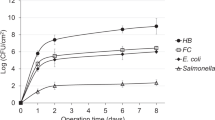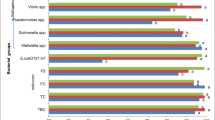Abstract
Seven full-scale wastewater treatment plants were investigated to highlight the effectiveness of each treatment stage on removing Escherichia coli. The primary sedimentation achieved an average E. coli removal efficiency of 30.5% which was much lower than the suspended solids (58%), thus, revealing the absence of a linear relationship between the two parameters. Biological processes proved to be very important in the removal of E. coli through adsorption inside the sludge flocs and complex decay (mortality). In biological processes with a long retention time, such as activated sludge denitrification-nitrification, the decay was very important, whereas in the more traditional activated sludge process, without nitrification, the contribution of adsorption and mortality was quite balanced. Overall, the mechanical-biological treatment achieved a removal efficiency of 91.8–96.5% depending on the process. Additional removal can be achieved by disinfection. The effectiveness of E. coli removal with sodium hypochlorite was strictly depended on the product of residual chlorine (C R) with the contact time (t). The experimental curve fitted the Collins model well, with a standard deviation of less than 7%.








Similar content being viewed by others
References
Bautista-Toledo, M. I., Espinosa-Iglesias, D., Carrasco-Marin, F., Pérez-Cardenas, A. F., & Maldonado, F. I. (2015). Influence of the physicochemical properties of inorganic supports on the activity of immobilized bacteria for water denitrification. Journal of Environmental Management, 156, 81–88. doi:10.1016/j.jenvman.2015.03.031.
Capodaglio, A.G., Hlavínek, P., & Raboni, M. (2015). Physico-chemical technologies for nitrogen removal from wastewaters: a review. Revista Ambiente & Agua, 481–498 (2015). doi:10.4136/ambi-agua.1618.
Carlos, C., Alexandrino, F., Stoppe, N. C., Sato, M. I. Z., & Ottoboni, L. M. M. (2012). Use of Escherichia coli BOX-PCR fingerprints to identify sources of fecal contamination of water bodies in the State of São Paulo, Brazil. Journal of Environmental Management, 93, 38–43. doi:10.1016/j.jenvman.2011.08.012.
Cavallini, G. S., de Campos, S. X., de Souza, J. B., & Vidal, C. M. D. (2013). Evaluation of the physical-chemical characteristics of wastewater after disinfection with peracetic acid. Water, Air, and Soil Pollution, 224(10), 1–11. doi:10.1007/s11270-013-1752-5.
Copelli, S., Raboni, M., & Urbini, G. (2015). Water pollution: biological oxidation and natural control techniques. In J. Reedijk (Ed.), Reference module in chemistry, molecular sciences and chemical engineering (pp. 1–28). Elsevier. doi:10.1016/B978-0-12-409547-2.11419-2.
EPA Victoria (2002). Guidelines for environmental management—disinfection of treated wastewater. Publication 730, September. ISBN 0 7306 7623 4.
Frigon, D., Biswal, B. K., Mazza, A., Masson, L., & Gehr, R. (2013). Biological and physicochemical wastewater treatment processes reduce the prevalence of virulent Escherichia coli. Applied and Environmental Microbiology, 79(3), 835–844. doi:10.1128/AEM.02789-12.
George, I., Crop, P., & Servais, P. (2002). Fecal coliform removal in wastewater treatment plants studied by plate counts and enzymatic methods. Water Research, 36, 2607–2617.
Hartman, L. J., Grimsley, G. A., Martin, A. E., & Register, K. M. (2006). A long-term study comparing membrane filtration with Colilert® defined substrates in detecting fecal coliforms and Escherichia coli in natural waters. Journal of Environmental Management, 80, 191–197. doi:10.1016/j.jenvman.2005.08.024.
Hwang, S.W. (2012). Optimizing Pathogen Destruction during Urban Wastewater Treatment to Provide for More Sustainable Effluent Disinfection. Proceedings of 1st Civil and Environmental Engineering Student Conference, Imperial College London, 25–26 June.
IRSA-Institute for Water Research of the National Research Council, APAT-Agency for the protection of the Environment and Technical Services (2003). Analytical methods for water-Report 29/2003, Rome, Italy.
Italian Parliament (2006). Legislative Decree No. 152 approving the Code on the Environment. Official Gazette of the Italian Republic No. 88, 14th April 2006.
Kazmi, A. A., Tyagi, V. K., Trivedi, R. C., & Kumar, A. (2008). Coliforms removal in full-scale activated sludge plants in India. Journal of Environmental Management, 87, 415–419. doi:10.1016/j.jenvman.2007.01.017.
Landa-Cansigno, O., Durán-Álvarez, J. C., & Jiménez-Cisneros, B. (2013). Retention of Escherichia coli, Giardia lamblia cysts and Ascaris lumbricoides eggs in agricultural soils irrigated by untreated wastewater. Journal of Environmental Management, 128, 22–29. doi:10.1016/j.jenvman.2013.04.049.
Massana, A. C., Gómez-Doñate, M., Sánchez, D., Belanche-Muñoz, L. A., Muniesa, M., & Blanch, A. R. (2015). Predicting fecal sources in waters with diverse pollution loads using general and molecular host-specific indicators and applying machine learning methods. Journal of Environmental Management, 151, 317–325. doi:10.1016/j.jenvman.2015.01.002.
Orruño, M., Garaizabal, I., Bravo, Z., Parada, C., Barcina, I., & Arana, I. (2014). Mechanisms involved in Escherichia coli and Serratia marcescens removal during activated sludge wastewater treatment. MicrobiologyOpen, 3(5), 657–667. doi:10.1002/mbo3.196.
Papa, M., Bertanza, G., & Abbà, A. (2016). Reuse of wastewater: a feasible option, or not? A decision support system can solve the doubt. Desalination and Water Treatment, 57(19), 8670–8682. doi:10.1080/19443994.2015.1029532.
Pignata, C., Fea, E., Rovere, R., Degan, R., Lorenzi, E., de Ceglia, M., Schilirò, T., & Gilli, G. (2012). Chlorination in a wastewater treatment plant: acute toxicity effects of the effluent and of the recipient water body. Environmental Monitoring and Assessment, 184, 2091–2103. doi:10.1007/s10661-011-2102-y.
Raboni, M., Torretta, V., Viotti, P., & Urbini, G. (2013a). Experimental plant for the physical-chemical treatment of groundwater polluted by Municipal Solid Waste (MSW) leachate, with ammonia recovery. Revista Ambiente & Agua, 8, 22–32. doi:10.4136/ambi-agua.1250.
Raboni, M., Torretta, V., & Urbini, G. (2013b). Influence of strong diurnal variations in sewage quality on the performance of biological denitrification in small community wastewater treatment plants (WWTPs). Sustainability, 5, 3679–3689. doi:10.3390/su5093679.
Raboni, M., Torretta, V., Viotti, P., & Urbini, G. (2014a). Pilot experimentation with complete mixing anoxic reactors to improve sewage denitrification in treatment plants in small communities. Sustainability., 6, 112–122. doi:10.3390/su6010112.
Raboni, M., Torretta, V., Viotti, P., & Urbini, G. (2014b). Calculating specific denitrification rates in pre-denitrification by assessing the influence of dissolved oxygen, sludge loading and the mixed-liquor recycle. Environmental Technology, 35, 2582–2588. doi:10.1080/09593330.2014.913690.
Raboni, M., Gavasci, R., & Viotti, P. (2015). Influence of denitrification reactor retention time distribution (RTD) on dissolved oxygen control and nitrogen removal efficiency. Water Science and Technology, 72, 45–51. doi:10.2166/wst.2015.188.
Semenov, A. V., van Overbeek, L., Termorshuizen, A. J., & van Bruggen, A. H. C. (2011). Influence of aerobic and anaerobic conditions on survival of Escherichia coli O157:H7 and Salmonella enterica serovar Typhimurium in Luria–Bertani broth, farm-yard manure and slurry. Journal of Environmental Management, 92, 780–787. doi:10.1016/j.jenvman.2010.10.031.
Soller, J., Embrey, M., Tuhela, L., Ichida, A., & Rosen, J. (2010). Risk-based evaluation of Escherichia coli monitoring data from undisinfected drinking water. Journal of Environmental Management, 291, 2329–2335. doi:10.1016/j.jenvman.2010.06.017.
Sorlini, S., Collivignarelli, M. C., & Canato, M. (2015a). Effectiveness in chlorite removal by two activated carbons under different working conditions: a laboratory study. Journal of Water Supply: Research and Technology-AQUA, 64(4), 450–461. doi:10.2166/aqua.2015.132.
Sorlini, S., Collivignarelli, M. C., Castagnola, F., Crotti, B. M., & Raboni, M. (2015b). Methodological approach for the optimization of drinking water treatment plants’ operation: a case study. Water Science and Technology, 71(4), 597–604. doi:10.2166/wst.2014.503.
Sorlini, S., Biasibetti, M., Collivignarelli, M. C., & Crotti, B. M. (2015c). Reducing the chlorine dioxide demand in final disinfection of drinking water treatment plants using activated carbon. Environmental Technology, 36(12), 1499–1509. doi:10.1080/09593330.2014.994043.
Sorlini, S., Biasibetti, M., Gialdini, F., & Collivignarelli, M. C. (2016). How can drinking water treatments influence chlorine dioxide consumption and by-product formation in final disinfection? Water Science and Technology: Water Supply, 16(2), 333–346. doi:10.2166/ws.2015.142.
Taegyu, K., & Jong-In, H. (2013). Fast detection and quantification of Escherichia coli using the base principle of the microbial fuel cell. Journal of Environmental Management, 130, 267–275. doi:10.1016/j.jenvman.2013.08.051.
Tchobanoglous, G., Burton, F. L., & Stensel, H. D. (2003). Wastewater engineering—treatment and reuse (4th ed.). New York: Mc Graw Hill.
Torretta, V., & Katsoyiannis, A. (2013). Occurrence of polycyclic aromatic hydrocarbons in sludges from different stages of a wastewater treatment plant in Italy. Environmental Technology, 34(7), 937–943. doi:10.1080/09593330.2012.722693.
U.S. Food & Drug Administration (2012). Bad Bug Book—Handbook of Foodborne Pathogenic Microorganisms and Natural Toxins (2nd Ed.), Center for Food Safety and Applied Nutrition (CFSAN) of the Food and Drug Administration (FDA), U.S. Department of Health and Human Services.
US-EPA, United States Environmental Protection Agency (2010). Nutrient Control Design Manual. Report EPA/600/R‐10/100. Office of Research and Development / National Risk Management Research Laboratory, Cincinnati, USA.
van der Drift, C., van Seggellen, E., Stumm, C., Hol, W., & Tuinte, J. (1977). Removal of Escherichia coli in wastewater by activated sludge. Applied and Environmental Microbiology, 34(9), 315–319.
Viotti, P., Collivignarelli, M. C., Martorelli, E., & Raboni, M. (2015). Oxygen control and improved denitrification efficiency by dosing ferrous ions in the anoxic reactor. Desalination and Water Treatment. doi:10.1080/19443994.2015.1089200.
Author information
Authors and Affiliations
Corresponding author
Ethics declarations
Conflict of Interest
The authors declare that they have no conflict of interest.
Rights and permissions
About this article
Cite this article
Raboni, M., Gavasci, R. & Torretta, V. Assessment of the Fate of Escherichia coli in Different Stages of Wastewater Treatment Plants. Water Air Soil Pollut 227, 455 (2016). https://doi.org/10.1007/s11270-016-3157-8
Received:
Accepted:
Published:
DOI: https://doi.org/10.1007/s11270-016-3157-8




